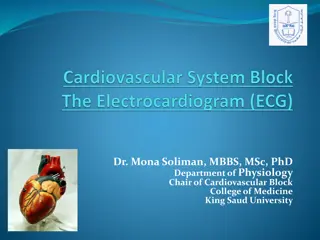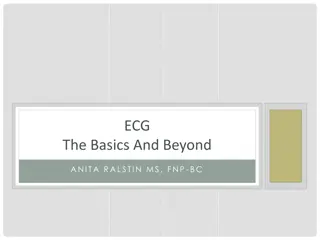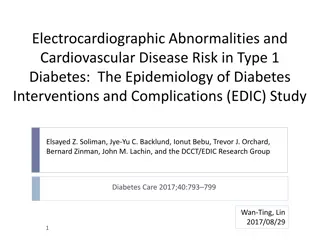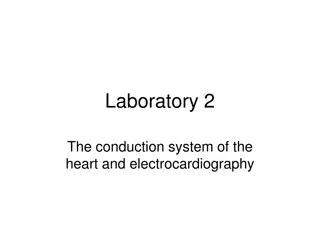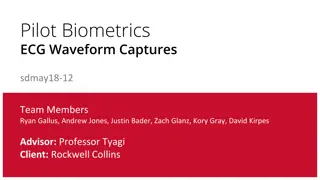
Understanding ECG Interpretation Basics
Learn the fundamentals of ECG interpretation from a clinical lecturer. Explore basic physiology, rhythm strips, lead locations, and more. Improve your skills and confidence in analyzing electrocardiograms.
Download Presentation

Please find below an Image/Link to download the presentation.
The content on the website is provided AS IS for your information and personal use only. It may not be sold, licensed, or shared on other websites without obtaining consent from the author. If you encounter any issues during the download, it is possible that the publisher has removed the file from their server.
You are allowed to download the files provided on this website for personal or commercial use, subject to the condition that they are used lawfully. All files are the property of their respective owners.
The content on the website is provided AS IS for your information and personal use only. It may not be sold, licensed, or shared on other websites without obtaining consent from the author.
E N D
Presentation Transcript
ECG Interpretation DR SAMANTHA SKINNER CLINICAL LECTURER UNIVERSITY OF ABERDEEN JUNE 2024
Electrocardiograms... Don t panic! Follow simple rules while getting used to interpretation Learn the basic physiology and ECGs will become easier to look at If you are in any doubt about a real patient, please quickly hand it over to a senior
Basic Physiology Electricity flows through the heart in a very organised and rapid fashion, starting in the pacemaker SA node. There is a slight delay at the AV node before the electricity travels through the ventricles from AV node, down bundle of His, then splitting into left and right bundles. Therefore, electricity should roughly flow from upper right to lower left, before spreading back up into the ventricles.
The rhythm strip Flow towards a lead results in a positive upwards deflection Flow away from a lead results in a negative downwards deflection 1 large square = 0.2 seconds (200 milliseconds) 1 small square = 0.04 seconds (40 milliseconds) So, 30 big squares = 6 seconds
Where are the leads? This is Einthoven s hexaxial diagram It shows what the QRS complexes should look like in a normal ECG based on axis, which is the direction of electrical flow Note that lead aVR looks to be upside down but that is because the flow is AWAY from that direction
Where are the leads? To work out the axis, or direction of electrical flow, we look at where the positive deflections appear in leads I, II and III If the positive QRS deflection is to lead I and is negative in lead III, then the pull of electricity is to the left and suggests a problem such as left ventricular hypertrophy If the positive QRS deflection is to lead III with a negative deflection in lead I, then it suggests the right side is conducting more electricity. Look at this doodle a smiley face suggests no axis deviation!
The complexes and what they mean The P wave is atrial depolarisation/contraction The QRS is ventricular depolarisation/contraction The T wave is ventricular repolarisation/relaxation (the atrial repolarisation gets swallowed up in the QRS complex) The PR interval is the time taken for the electricity to get from the atria to the ventricles (0.12-0.2 seconds or 3-5 small squares) The QRS interval is the time taken for the ventricles to depolarise and contract (less than 0.12 seconds or 3 small squares)
The ECG Check the patient details on the ECG Date and time it was taken why was it taken and any symptoms at the time Rate Rhythm Axis Any abnormality of the complexes eg ST elevation or T wave inversion Comparison to old ECGs Your interpretation
6-stage approach or ARIBAR Is there electrical a activity with a pulse? What is the r rate? Is it regular or i irregular? Are the QRS complexes normal or b broad (>3 small squares)? Are there P waves present (a atrial activity)? What is the r relationship between the P waves and the QRS complexes? Start asking these questions every time you look at an ECG to get the rate and rhythm
Following the 6-stage approach Is there electrical activity with a pulse? What is the rate (count 30 large squares, count the R waves and multiply by 10 or count the big squares between two consecutive R waves and then do 300/that number of big squares)? Regular or irregular? Is the QRS normal or broad? Are there P waves? What is the relationship between the P waves and the QRS complexes?
Heart blocks Heart blocks are all about the communication between the atria and the ventricles, or the P wave and the QRS on the ECG It describes an AV block, of which there are a few! 1stdegree heart block = prolonged PR interval. The P and QRS are still firing along together but are slightly further apart as the signal takes a bit longer to get through the AV node 2nddegree heart block / Mobitz type 1 (aka Wenckebach) = the AV node gets more and more fatigued so you see the PR interval getting gradually longer before the AV node becomes too tired and you lose a QRS complex. Then the pattern starts again
Heart blocks continued... Second degree heart block / Mobitz type 2 = the random disappearance of a QRS complex on the ECG as the AV node becomes so tired of conducting that it suddenly does not transmit the signal. The pattern is irregular or can be in a fixed ratio and is most likely to progress to a complete heart block or haemodynamic instability Third degree heart block /complete heart block = the atria and ventricles are no longer communicating with each other at all. As such, the atria continue contracting at their own regular pace and pacemaker cells in the ventricles take over, causing the ventricles to contract at a different pace. Remember, the further down in the ventricles the pacemaker cells are firing from, the slower and usually wider the QRS complex will be
Now that we can work out the rate and rhythm... We can now look for abnormalities in each lead and see which area of the heart is involved If we know which area is affected, we can work out the most likely culprit artery Anterior and septal = left anterior descending artery (LAD) Lateral = left coronary artery (LCA) circumflex branch Inferior = right coronary artery (RCA) posterior descending branch Posterior = LCA and RCA
Look at each lead logically Work through the complexes, looking for abnormalities such as ST segment elevation or depression, T wave inversion or Q waves Always relate the findings to the clinical picture and remember that a normal ECG does not rule out a coronary syndrome Let s look at some examples, going through the 6-stage approach and then looking at the leads and their complexes






